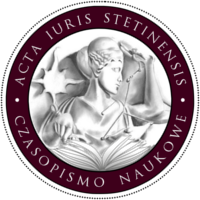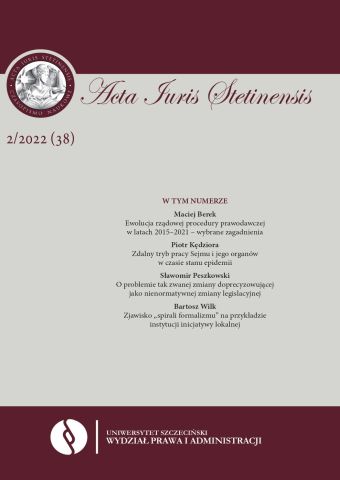







| Authors: |
Sławomir
Peszkowski

Krajowa Szkoła Administracji Publicznej im. Prezydenta RP Lecha Kaczyńskiego |
| Keywords: | clarifying amendment normative amendment non-normative amendment legislation |
| Data publikacji całości: | 2022 |
| Page range: | 30 (159-188) |
| Downloads ?: | 490 |
| 1. | Bielska-Brodziak A., Tobor Z., Zmiana w przepisach jako argument w dyskursie interpretacyjnym, „Państwo i Prawo” 2009, z. 9. |
| 2. | Błachut M., Gromski W., Kaczor J., Technika prawodawcza, Warszawa 2008. |
| 3. | Brzeziński B., Podstawy wykładni prawa podatkowego, Gdańsk 2008. |
| 4. | Czepita S., Wronkowska S., Zieliński M., Założenia szkoły poznańsko-szczecińskiej w teorii prawa, „Państwo i Prawo”, 2013, z. 2. |
| 5. | Grzybowski T., Wpływ zmian prawa na jego wykładnię, Warszawa 2013. |
| 6. | Kanarek B., Teoretyczne ujęcia derogacji, Szczecin 2004. |
| 7. | Leszczyński J., Pozytywizacja prawa w dyskursie dogmatycznym, Kraków 2010. |
| 8. | Nowacki J., Przepis prawny a norma prawna, Katowice 1988. |
| 9. | Nowacki J., Tobor Z., Wstęp do prawoznawstwa, Zakamycze 2000. |
| 10. | Radziewicz P., Przywrócenie mocy obowiązującej przepisu prawnego jako skutek orzeczenia Trybunału Konstytucyjnego, „Przegląd Sejmowy” 2005, nr 3. |
| 11. | Wronkowska S., Niektóre problemy eliminowania norm z systemu prawnego, w: Tworzenie prawa. Zbiór studiów, Warszawa 1987. |
| 12. | Wronkowska S., Ziembiński Z., Zarys teorii prawa, Poznań 2001. |
| 13. | Wronkowska S., Zieliński M., Komentarz do Zasad techniki prawodawczej, Warszawa 2021. |
| 14. | Wróbel W., Zmiana normatywna i zasady intertemporalne w prawie karnym, Zakamycze 2003. |
| 15. | Wróblewski J., Tworzenie prawa a wykładnia prawa, w: J. Wróblewski, Pisma wybrane, wybór i wstęp M. Zirk-Sadowski, Warszawa 2015. |
| 16. | Zieliński M., Interpretacja jako proces dekodowania tekstu prawnego, Poznań 1972. |
| 17. | Zieliński M., Wykładnia prawa. Zasady-reguły-wskazówki, Warszawa 2017. |
| 18. | Ziembiński Z., Przepis prawny a norma prawna, „Ruch Prawniczy, Ekonomiczny i Socjologiczny” 1960, nr 1. |
| 19. | Ziembiński Z., „Akt normatywny” czy „akt prawotwórczy”?, „Państwo i Prawo” 1993, z. 11–12. |